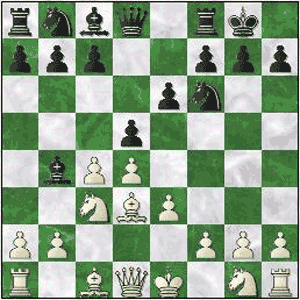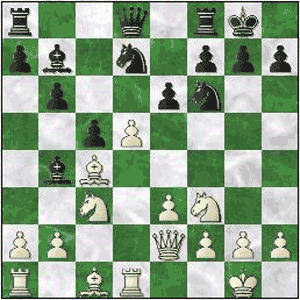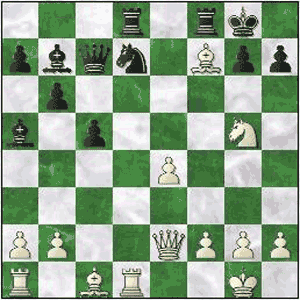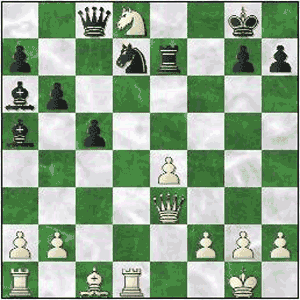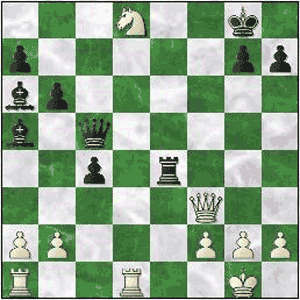| Back to Back Issues Page |
 |
|
LCB, Issue #035 --, Win with Sacrificial Decoys April 01, 2018 |
Win with the Sacrificial DecoyLapoc Chess Board, Issue #035 -- GOTM #4 learn and play online chess This month we are in Leningrad, Russia for a game between two GMs of the 20th Century Soviet world. The prominent and respected Lev Polugaevsky takes on the future World Champion, Tigran Petrosian (Iron Tigran). The year is 1960 and the game is played in the USSR Championship. They find themselves in a QGD and Polugaevsky manages to get his central pawns moving, although not in concert. His Queen's pawn is first to charge, causing the initial panic. This pawn is finally dealt with on the seventh rank but the stage is set for the King's pawn to march into Black's camp. He does so to great effect as you will see in the game. Win with the Sacrificial DecoyPolugaevsky, Lev - Petrosian, Tigran V [E54]GotM #4 - Leningrad, 1960 1.d4 Nf6 2.c4 e6 3.Nc3 Bb4 4.e3 0-0 5.Bd3 d5
The game transposes to a Queen's Gambit Declined. 6.Nf3 c5 Black attacks the center with the thematic strike ...c5 7.0-0 dxc4 8.Bxc4 b6 9.Qe2 Bb7 10.Rd1 Nbd7 Develops the Knight and seems to give the Queen some more cover but she still feels the heat of the Rook's x-ray. 11.d5
(11.dxc5 would have allowed Black to equalize as follows: 11...Bxc5 12.b3 Qe7 13.Bb2 Rad8 14.h3 Bxf3 15.Qxf3 Ne5 16.Qf4 Nxc4 17.Qxc4 Rxd1+ 18.Rxd1 Rd8 19.Rd3 h6=) 11...Bxc3 12.dxe6! White steals a crucial pawn and move. He also ensures that by attacking the Knight, he will not fall a piece behind. This move tears Black's center to pieces. (If 12.bxc3 then White would have lost is impetus in the center: 12...exd5 13.Bb5 Ne4 14.Bb2 Ndf6 15.Ne5 Qc7 16.c4 a6 17.Ba4 dxc4 18.Nxc4 b5 19.f3 bxa4 20.Be5 Qe7 21.fxe4 Nxe4 22.Qb2 f6 23.Bd6 Nxd6 24.Rxd6 Rab8 25.Qd2 Rfe8 26.Rc1 h6-+ and Black has the upper hand.) 12...Ba5 (12...fxe6 13.Bxe6+ Kh8 14.bxc3+/-) 13.exd7 Qc7 (13...Nxd7 is perhaps a better plan, leading to play such as 14.e4 Qc7 15.Bg5 Rae8 16.Bd5 Bc6 17.Bf4 Qb7 18.Bxc6 Qxc6 19.e5 Nf6 20.Rac1 Nd5 21.Qe4 Rd8 22.Bg5 Nb4 23.Qb1 (23.Qxc6 Rxd1+ 24.Rxd1 Nxc6 25.h3+/=) 23...Rxd1+ 24.Rxd1 h6 25.Bd2 Rd8 26.a3 Nd5 27.Bxa5 bxa5 28.h3 Rd7+/= with Black still well in the game) 14.e4 Nxd7 15.Ng5 Rad8 16.Bxf7+!
The key move of the game. Using an ingenious decoy, White disorientates Black's forces. He will later capitalize on the disharmony by advancing his passed pawn into the enemy camp. 16...Rxf7 17.Ne6 Qc8 18.Nxd8 Ba6 (Taking the Knight is the best policy: 18...Qxd8 19.e5 Qe8 20.e6 Rf6 21.exd7 Qxe2 22.d8Q+ Rf8 23.Be3 Rxd8 24.Rxd8+ Kf7 25.Rd7+ Kg6 26.Rxb7 Qxb2 27.Rd1 Bd2 28.Bxd2 Qc2 29.Rf1 Qxd2 30.Rxa7 b5 31.Ra6+ Kf5=/+ and these two Queenside pawns give Black a small advantage.) 19.Qe3 Re7??
Now White will be able to preserve his Knight. (Now taking the Knight will not lead to equality but is was still his best chance. 19...Qxd8 20.e5 Bc4 (20...Re7 leads to the same position: 21.e6 Bc4) 21.e6 Re7 22.Rxd7 Rxd7 23.exd7 Qxd7+/-) 20.Qb3+ c4 (20...Kh8 amounts to an exchange sacrifice 21.Nf7+ Rxf7 (21...Kg8?? 22.Nd6++-) 22.Qxf7+-; 20...Kf8 sees Black getting into all sorts of difficulties, 21.Ne6+ Ke8 22.Bg5 c4 (22...Rf7 is answered by 23.Nxg7+ Kf8 (23...Rxg7 allows 24.Qe6+ Kf8 25.Bh6 Bc4 26.Bxg7+ Kxg7 27.Rxd7+ Qxd7 28.Qxd7++-) 24.Nf5 forcing 24...Rxf5 25.exf5+-) 23.Qh3 Nf6 24.Rd8+ Qxd8 25.Nxd8 Kxd8 26.Rd1+ Kc7 27.Qa3 Rxe4 28.Bxf6 Bb5 (If 28...gxf6 the recapture will be punished by 29.Qd6+ Kb7 30.Qd5+ Kb8 31.Qxe4+-) 29.Bc3 Kb7+-) 21.Qa3 Nc5 (21...Re8 doesn't work because of 22.Qd6 Qxd8 (22...Rxd8 is no better: 23.Bg5 Re8 24.Qxd7 Qxd7 25.Rxd7 Rxe4+-) 23.Qd5+ Kf8 24.Bg5 Qc8 25.Qxd7 Bb7 26.Qd6+ Kg8 27.f3 b5 28.Be3 Bc7 29.Qb4 a6 30.a4 Bc6+-; Moving back into the pin with 21...Qxd8? is never good as can be seen by 22.Bg5! pinning the Rook to the Queen too and this piece is in trouble. Black would be forced to scramble with 22...Kf7 23.e5 Qe8 Escaping both pins 24.Qf3+ Kg8 25.Bxe7 Nxe5 (Not 25...Qxe7 because of 26.Qd5+ Kf8 27.Qxd7 c3 28.bxc3 h5 29.e6 Bxc3 30.Rac1 Bf6 31.Rc6+- with a clear advantage for White.) 26.Qd5+ Nf7 27.Qe6 Bc8 28.Qxc4 b5 29.Qe4 g6 30.Qa8 Qxe7 31.Qxc8+ Kg7 And now the White Rooks join the attack with decisive effect: 32.Rd7 Qf6 33.Rad1 Bb6 34.Rxf7+ Qxf7 35.Rd7 Bxf2+ 36.Kf1 Bh4+ 37.Rxf7+ Kxf7 38.Qd7+ Be7 39.Qxb5 g5+- with an easy win for White.) 22.Be3 Rxe4 23.Bxc5 Qxc5 24.Qf3
Here Black resigns. (24.Qf3 There's no defense to the coming onslaught: 24...Re7 must be played to defend f7 but it allows 25.Ne6 Qc8 26.Rd8+ Qxd8 27.Nxd8+-; 24.Qxc5 is also winning for White but isn't anywhere near as clear-cut. Black can fight on much longer: 24...bxc5 25.Nc6 Bb6 26.Re1 Rf4 27.Re8+ Rf8 28.Rxf8+ Kxf8 29.Rc1 Ke8 30.Ne5 Bc7 31.Nxc4 Kd7 32.Nd2 Kc6 33.b4 Bd6 34.Ne4 c4 35.Nxd6 Kxd6 36.f3 Kd5 37.Rd1+ Kc6 38.a4 Bc8 39.Kf2 Bf5 40.Rd4 Be6+- And when the pawn is captured even if at the price of an exchange sacrifice, then White will have majorities on both wings and the outcome is not in doubt.) 1-0 Polugaevsky - Petrosian (Leningrad, 1960) P.S. If you do not have html based email software and you're using a text only system, you may find that the links are only partially highlighted and may not work. If this is the case, simply copy and paste the entire link into the browser and hit Enter. That should get you where you want to go. Comments, ideas, feedback? I'd be stoked to hear from you. Get in touch See you next month. Ken 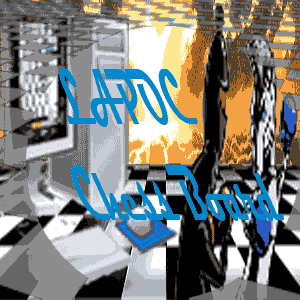
|
| Back to Back Issues Page |
